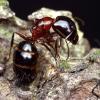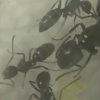Earlier today, I took my Camponotus hyatti colony of 30 workers that I bought from a GAN Farmer in Sacramento, out of hibernation. They've been in a wine cooler set to 45 degrees since November 11. A few minutes after taking them out and putting them in my room which was about 74 degrees, they looked as if they came back to life. Then about an hour later, I saw a major and minor lying on their side, seemingly lifeless. I thought maybe they were too warm so I put the colony in my garage which had cooler temps and almost immediately the major and minor got back up. I left them in my garage for 1-2 hours, then moved them to my dining room where it was room temperature. When I checked around 6 PM, I saw that the queen was now lying on her side, with only little antennae movement. I let them be for about 3 hours and at 9 PM I checked on them and the queen was still lying on her side with little antennae movement. I put them back in the wine cooler thinking I might have taken them out of hibernation too early, and checked up on them 30 minutes later and saw that queen had more movement. Any thoughts? Did I take them out too early?
- Formiculture.com
- Forums
- Gallery
- Members
- Member Map
- Chat


















